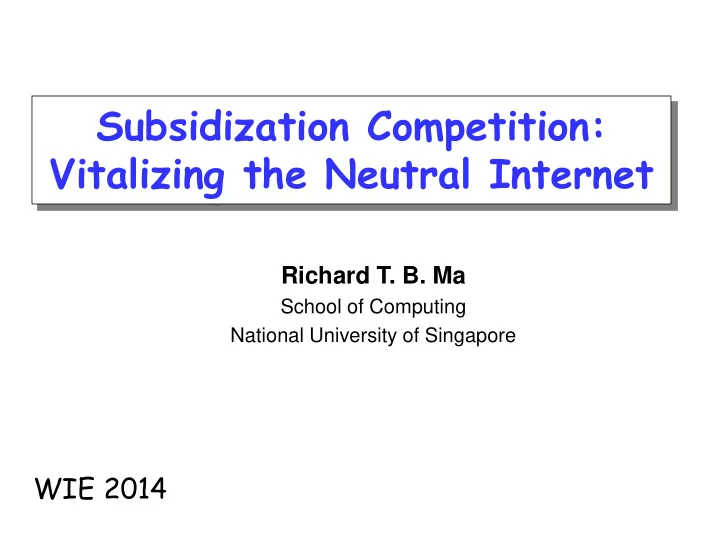

Subsidization Competition: Vitalizing the Neutral Internet Richard T. B. Ma School of Computing National University of Singapore WIE 2014
Internet’s two -sided market Problem is not in the transit market Fiber optics backbone, rare congestion Competitive market with declining prices CPs bypass Tier-1 ISPs to improve performance But in the mobile access market High mobile infrastructure costs One-side pricing from end-users Lower profit margin than those of the CPs Few incentives for investments
About this work P ropose and study “subsidization competition” CPs could voluntarily subsidize its users’ usage costs Differences to sponsored data plan/”zero rate” Partial subsidization is allowed 1. ISPs charge the same per-unit rate, regardless the 2. source of revenue (no secret deals with CPs)
Basic system model 𝒏, 𝜈 Focus on an access ISP with capacity 𝜈 and a set 𝒪 of CPs. For each 𝑗 ∈ 𝒪 , denote 𝑛 𝑗 : user size, 𝜇 𝑗 : avg per user throughput 𝜄 𝑗 ≜ 𝑛 𝑗 𝜇 𝑗 as throughput and 𝜄 ≜ 𝜄 𝑗 𝑗∈𝒪 Define 𝜚 ≜ Φ 𝜄, 𝜈 as the system utilization Φ 𝜄, 𝜈 ↗ 𝜄; Φ 𝜄, 𝜈 ↘ 𝜈 can be seen as system congestion User throughput satisfies 𝜇 𝑗 ≜ 𝜇 𝑗 𝜚 ↘ 𝜚
Basic system model 𝒏, 𝜈 𝜚 is the utilization of a system 𝒏, 𝜈 iff , 𝜈 𝜚 = Φ 𝑛 𝑗 𝜇 𝑗 𝜚 𝑗∈𝒪 utilization is unique throughput of CPs
One-sided pricing model If ISP charges 𝑞 , its revenue is 𝑆 ≜ 𝑞𝜄 User size: 𝑛 𝑗 ≜ 𝑛 𝑗 𝑞 ↘ 𝑞
One-sided pricing model Price effect: 𝜖𝜚 𝜖𝑞 ≤ 0; 𝜖𝜄 𝜖𝑞 ≤ 0. CP 𝑗 ’s throughput 𝜄 𝑗 increases with price 𝑞 iff 𝜇 𝑗 < −𝜗 𝑞 𝑛 𝑗 /𝜗 𝜚 𝜚 𝜗 𝑞 𝑧 ≜ 𝜖𝑧 𝑦 where 𝜗 𝑦 𝑧 denotes the x-elasticity of y. 𝜖𝑦 𝑛 𝑗 small: users are not price sensitive 𝜗 𝑞 𝜇 𝑗 large: traffic is very sensitive to congestion 𝜗 𝜚
Subsidization model Denote 𝑟 as a policy that limits the subsidy, each CP 𝑗 choose to subsidize 𝑡 𝑗 ∈ 0, 𝑟 Denote 𝒕 as the strategy profile of the CPs User size becomes 𝑛 𝑗 = 𝑛 𝑗 𝑢 𝑗 = 𝑛 𝑗 𝑞 − 𝑡 𝑗 CP’s utility becomes 𝑉 𝑗 = 𝑤 𝑗 − 𝑡 𝑗 𝜄 𝑗 Define social welfare 𝑋 = 𝑤 𝑗 𝜄 𝑗 𝑗∈𝒪
Subsidization model
Nash equilibrium For price 𝑞 and policy 𝑟 , a strategy profile 𝒕 is a Nash equilibrium iff each 𝑡 𝑗 solves 𝑁𝑏𝑦 𝑉 𝑗 𝑡 𝑗 ; 𝒕 −𝑗 = 𝑤 𝑗 − 𝑡 𝑗 𝜄 𝑗 𝒕 𝑡. 𝑢. 0 ≤ 𝑡 𝑗 ≤ 𝑟. There exists a unique Nash equilibrium if for any 𝑡 ′ ≠ 𝑡 , there always exist CP 𝑗 such that ′ − 𝑡 𝑗 < 0 𝑡 𝑗 𝑣 𝑗 𝒕′ − 𝑣 𝑗 𝒕 where 𝑣 𝑗 = 𝜖𝑉 𝑗 𝒕 /𝜖𝑡 𝑗 defines the marginal utility.
Dynamics of equilibrium If a CP 𝑗 ’s profitability increases unilaterally ′ ≥ 𝑡 𝑗 . from 𝑤 𝑗 to 𝑤 𝑗 ′ , under Nash equilibrium, 𝑡 𝑗 Dynamics of the Nash equilibrium: 𝑗𝑔 𝑡 𝑗 = 0 0 𝜖s 𝑗 𝜖𝑟 = 1 𝑗𝑔 𝑡 𝑗 = 𝑟 ⋯ 𝑝𝑢ℎ𝑓𝑠𝑥𝑗𝑡𝑓 𝜖s 𝑗 𝜖𝑞 = 0 𝑗𝑔 𝑡 𝑗 = 0 𝑝𝑠 𝑡 𝑗 = 𝑟 ⋯ 𝑝𝑢ℎ𝑓𝑠𝑥𝑗𝑡𝑓
Policy implications Result: Under fixed price 𝑞 , if marginal utility matrix is off-diagonally monotone, 𝜖𝜚 𝜖𝑆 𝜖𝑟 ≥ 0 𝑏𝑜𝑒 𝜖𝑡 𝑗 𝜖𝑟 ≥ 0 ∀𝑗 ∈ 𝒪 𝜖𝑟 ≥ 0, Deregulation incentivize CPs to subsidize, increase system utilization and ISP revenue Implications: deregulation is desirable for improving investment incentives for ISPs
Policy under ISP’s optimal price Consider a 3-stage game: Regulator chooses policy 𝑟 1. ISP chooses optimal price 𝑞 𝑟 2. CPs choose subsidies 𝒕 3. 𝑒𝑛 𝑗 𝑒𝜚 𝑒𝜇 𝑗 Policy effect: 𝑒𝑟 = ⋯ 𝑒𝑟 = ⋯ , 𝑒𝑟 = ⋯ , CP 𝑗 ’s 𝜄 𝑗 decreases with relaxed policy 𝑟 iff 𝜇 𝑗 = 𝜗 𝑟 𝜇 𝑗 > −𝜗 𝑟 𝑛 𝑗 𝜗 𝑟 𝑢 𝑗 /𝜗 𝜚 𝑛 𝑗 / 𝜗 𝜚 𝜚 𝜗 𝑢 𝑗 𝑛 𝑗 small: users are not price sensitive 𝜗 𝑢 𝑗 𝜇 𝑗 large: traffic is sensitive to congestion 𝜗 𝜚 𝑢 𝑗 small: CP is less profitable 𝜗 𝑟
Revenue and social welfare Relaxed policy induces higher 𝑆 and 𝑋 Price regulation might be needed
Conclusions Study subsidization competition among CPs, ISP uses the same per-unit charge Partial subsidy is allowed Properties the network is physically neutral it creates a feedback loop for CPs to compete increase access revenue and attract investment Caveats Utilization will increase, some CPs have lower rates ISP’s price might need to be regulated if the market is not competitive enough
FCC Open Internet Order Transparency must disclose network management practices, performance characteristics, and … No blocking may not block lawful content, applications, services, non- harmful devices … No unreasonable discrimination may not unreasonably discriminate in transmitting lawful network traffic …
How do we want to regulate? It is about “no unreasonable discrimination” Existing solution impose an absolute minimum requirement for ordinary class however, ISPs have different capacities … Our proposal restrict the maximum gap in service quality implication: if you make premium class better, you need to make ordinary class better too.
References Richard T. B. Ma. “Subsidization Competition: Vitalizing the Neutral Internet .” ACM CoNEXT Conference 2014 Jing Tang and Richard T. B. Ma. “Regulating Monopolistic ISPs Without Neutrality.” IEEE ICNP Conference, 2014.
Recommend
More recommend